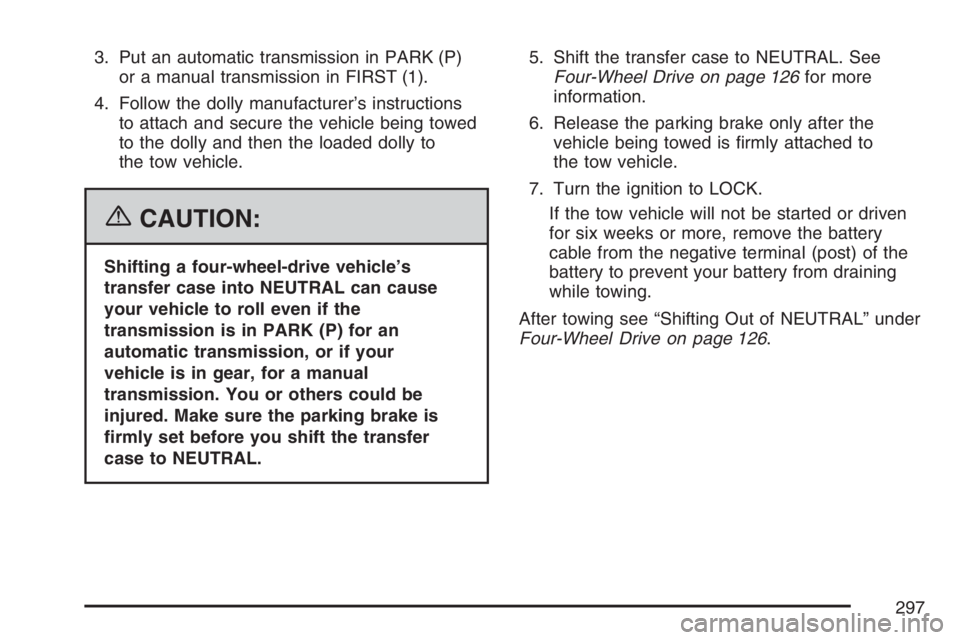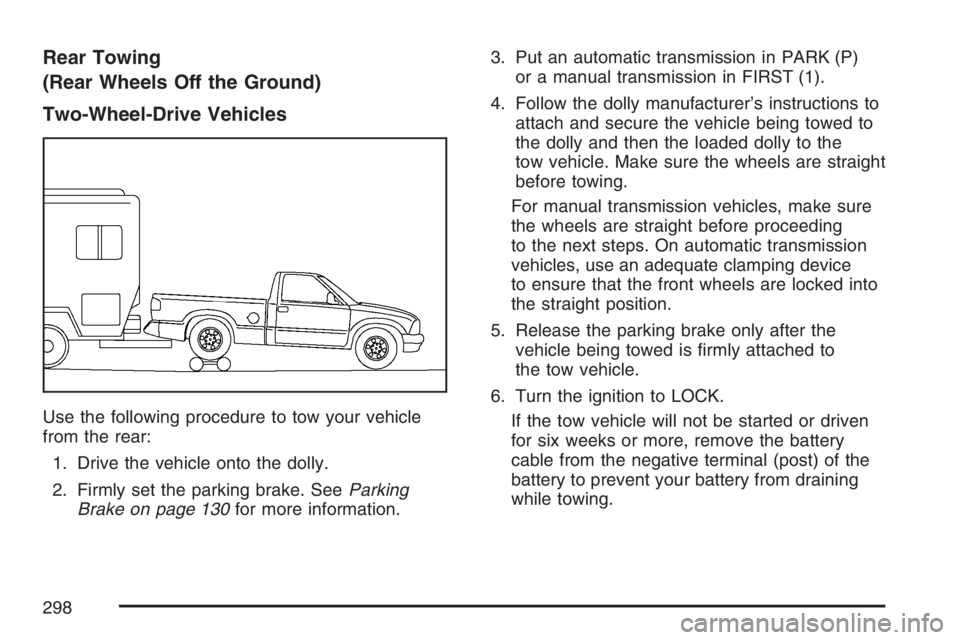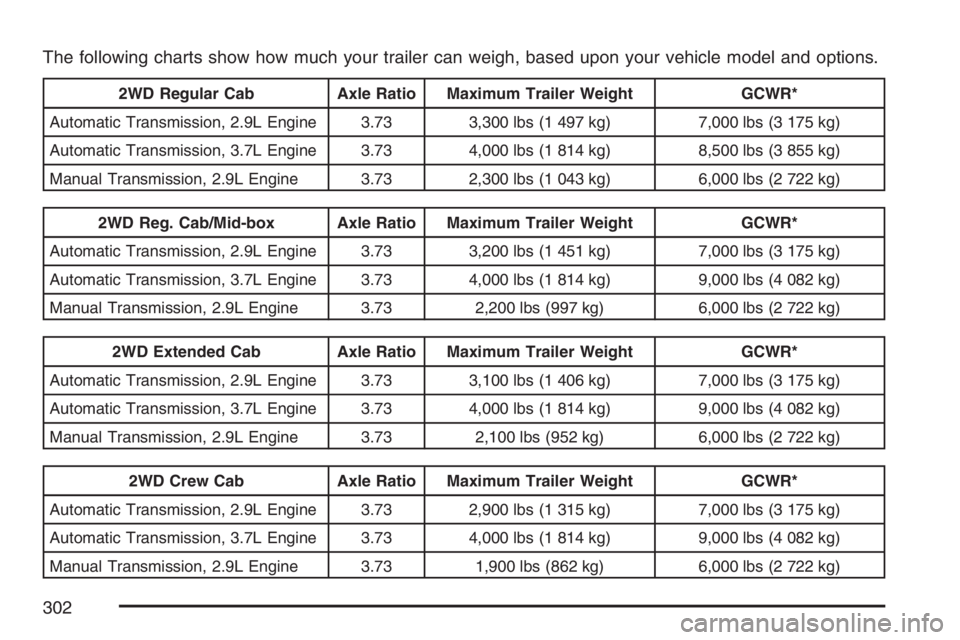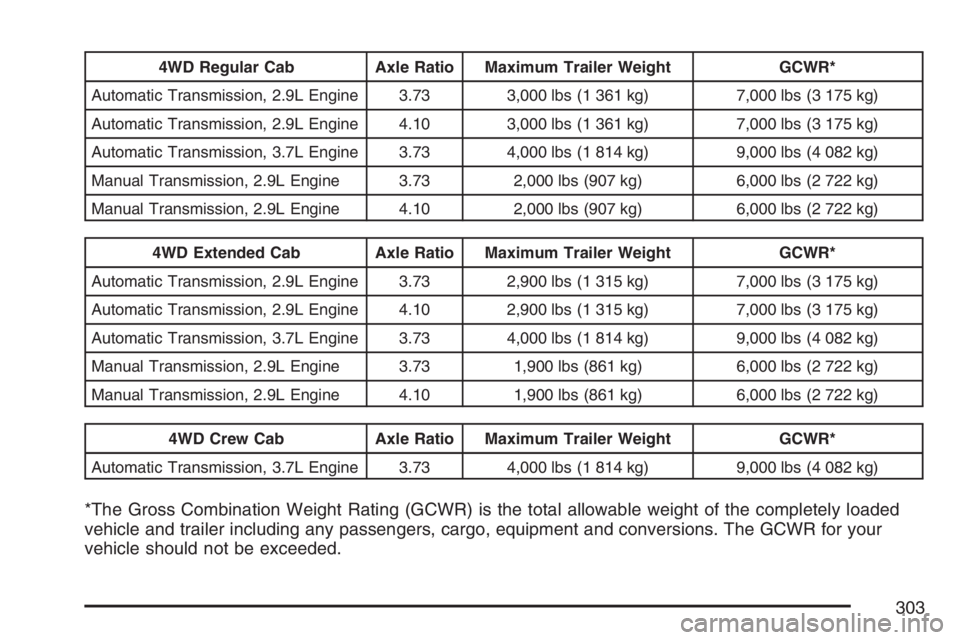2007 GMC CANYON automatic transmission
[x] Cancel search: automatic transmissionPage 297 of 492

3. Put an automatic transmission in PARK (P)
or a manual transmission in FIRST (1).
4. Follow the dolly manufacturer’s instructions
to attach and secure the vehicle being towed
to the dolly and then the loaded dolly to
the tow vehicle.
{CAUTION:
Shifting a four-wheel-drive vehicle’s
transfer case into NEUTRAL can cause
your vehicle to roll even if the
transmission is in PARK (P) for an
automatic transmission, or if your
vehicle is in gear, for a manual
transmission. You or others could be
injured. Make sure the parking brake is
�rmly set before you shift the transfer
case to NEUTRAL.5. Shift the transfer case to NEUTRAL. See
Four-Wheel Drive on page 126for more
information.
6. Release the parking brake only after the
vehicle being towed is �rmly attached to
the tow vehicle.
7. Turn the ignition to LOCK.
If the tow vehicle will not be started or driven
for six weeks or more, remove the battery
cable from the negative terminal (post) of the
battery to prevent your battery from draining
while towing.
After towing see “Shifting Out of NEUTRAL” under
Four-Wheel Drive on page 126.
297
Page 298 of 492

Rear Towing
(Rear Wheels Off the Ground)
Two-Wheel-Drive Vehicles
Use the following procedure to tow your vehicle
from the rear:
1. Drive the vehicle onto the dolly.
2. Firmly set the parking brake. SeeParking
Brake on page 130for more information.3. Put an automatic transmission in PARK (P)
or a manual transmission in FIRST (1).
4. Follow the dolly manufacturer’s instructions to
attach and secure the vehicle being towed to
the dolly and then the loaded dolly to the
tow vehicle. Make sure the wheels are straight
before towing.
For manual transmission vehicles, make sure
the wheels are straight before proceeding
to the next steps. On automatic transmission
vehicles, use an adequate clamping device
to ensure that the front wheels are locked into
the straight position.
5. Release the parking brake only after the
vehicle being towed is �rmly attached to
the tow vehicle.
6. Turn the ignition to LOCK.
If the tow vehicle will not be started or driven
for six weeks or more, remove the battery
cable from the negative terminal (post) of the
battery to prevent your battery from draining
while towing.
298
Page 299 of 492

Four-Wheel-Drive Vehicles
Use the following procedure to tow your vehicle
from the rear:
1. Drive the vehicle onto the dolly.
2. Firmly set the parking brake. SeeParking
Brake on page 130for more information.
3. Put an automatic transmission in PARK (P)
or a manual transmission in FIRST (1).
4. Follow the dolly manufacturer’s instructions
to attach and secure the vehicle being towed
to the dolly and then the loaded dolly to
the tow vehicle.For manual transmission vehicles, make sure
the wheels are straight before proceeding
to the next steps. On automatic transmission
vehicles, use an adequate clamping device
to ensure that the front wheels are locked into
the straight position.
{CAUTION:
Shifting a four-wheel-drive vehicle’s
transfer case into NEUTRAL can cause
your vehicle to roll even if the
transmission is in PARK (P) for an
automatic transmission, or if your vehicle
is in gear, for a manual transmission.
You or others could be injured. Make sure
the parking brake is �rmly set before you
shift the transfer case to NEUTRAL.
5. Shift the transfer case to NEUTRAL. See
Four-Wheel Drive on page 126for more
information.
6. Release the parking brake only after the
vehicle being towed is �rmly attached to the
tow vehicle.
299
Page 302 of 492

The following charts show how much your trailer can weigh, based upon your vehicle model and options.
2WD Regular Cab Axle Ratio Maximum Trailer Weight GCWR*
Automatic Transmission, 2.9L Engine 3.73 3,300 lbs (1 497 kg) 7,000 lbs (3 175 kg)
Automatic Transmission, 3.7L Engine 3.73 4,000 lbs (1 814 kg) 8,500 lbs (3 855 kg)
Manual Transmission, 2.9L Engine 3.73 2,300 lbs (1 043 kg) 6,000 lbs (2 722 kg)
2WD Reg. Cab/Mid-box Axle Ratio Maximum Trailer Weight GCWR*
Automatic Transmission, 2.9L Engine 3.73 3,200 lbs (1 451 kg) 7,000 lbs (3 175 kg)
Automatic Transmission, 3.7L Engine 3.73 4,000 lbs (1 814 kg) 9,000 lbs (4 082 kg)
Manual Transmission, 2.9L Engine 3.73 2,200 lbs (997 kg) 6,000 lbs (2 722 kg)
2WD Extended Cab Axle Ratio Maximum Trailer Weight GCWR*
Automatic Transmission, 2.9L Engine 3.73 3,100 lbs (1 406 kg) 7,000 lbs (3 175 kg)
Automatic Transmission, 3.7L Engine 3.73 4,000 lbs (1 814 kg) 9,000 lbs (4 082 kg)
Manual Transmission, 2.9L Engine 3.73 2,100 lbs (952 kg) 6,000 lbs (2 722 kg)
2WD Crew Cab Axle Ratio Maximum Trailer Weight GCWR*
Automatic Transmission, 2.9L Engine 3.73 2,900 lbs (1 315 kg) 7,000 lbs (3 175 kg)
Automatic Transmission, 3.7L Engine 3.73 4,000 lbs (1 814 kg) 9,000 lbs (4 082 kg)
Manual Transmission, 2.9L Engine 3.73 1,900 lbs (862 kg) 6,000 lbs (2 722 kg)
302
Page 303 of 492

4WD Regular Cab Axle Ratio Maximum Trailer Weight GCWR*
Automatic Transmission, 2.9L Engine 3.73 3,000 lbs (1 361 kg) 7,000 lbs (3 175 kg)
Automatic Transmission, 2.9L Engine 4.10 3,000 lbs (1 361 kg) 7,000 lbs (3 175 kg)
Automatic Transmission, 3.7L Engine 3.73 4,000 lbs (1 814 kg) 9,000 lbs (4 082 kg)
Manual Transmission, 2.9L Engine 3.73 2,000 lbs (907 kg) 6,000 lbs (2 722 kg)
Manual Transmission, 2.9L Engine 4.10 2,000 lbs (907 kg) 6,000 lbs (2 722 kg)
4WD Extended Cab Axle Ratio Maximum Trailer Weight GCWR*
Automatic Transmission, 2.9L Engine 3.73 2,900 lbs (1 315 kg) 7,000 lbs (3 175 kg)
Automatic Transmission, 2.9L Engine 4.10 2,900 lbs (1 315 kg) 7,000 lbs (3 175 kg)
Automatic Transmission, 3.7L Engine 3.73 4,000 lbs (1 814 kg) 9,000 lbs (4 082 kg)
Manual Transmission, 2.9L Engine 3.73 1,900 lbs (861 kg) 6,000 lbs (2 722 kg)
Manual Transmission, 2.9L Engine 4.10 1,900 lbs (861 kg) 6,000 lbs (2 722 kg)
4WD Crew Cab Axle Ratio Maximum Trailer Weight GCWR*
Automatic Transmission, 3.7L Engine 3.73 4,000 lbs (1 814 kg) 9,000 lbs (4 082 kg)
*The Gross Combination Weight Rating (GCWR) is the total allowable weight of the completely loaded
vehicle and trailer including any passengers, cargo, equipment and conversions. The GCWR for your
vehicle should not be exceeded.
303
Page 309 of 492

Backing Up
Hold the bottom of the steering wheel with
one hand. Then, to move the trailer to the left, just
move that hand to the left. To move the trailer to the
right, move your hand to the right. Always back up
slowly and, if possible, have someone guide you.
Making Turns
Notice:Making very sharp turns while
trailering could cause the trailer to come in
contact with the vehicle. Your vehicle could
be damaged. Avoid making very sharp
turns while trailering.
When you’re turning with a trailer, make wider
turns than normal. Do this so your trailer
won’t strike soft shoulders, curbs, road signs,
trees or other objects. Avoid jerky or sudden
maneuvers. Signal well in advance.
Turn Signals When Towing a Trailer
When you tow a trailer, your vehicle has to have
extra wiring and a heavy-duty turn signal �asher.
The arrows on your instrument panel will �ash
whenever you signal a turn or lane change.
Properly hooked up, the trailer lamps will also
�ash, telling other drivers you’re about to
turn, change lanes or stop.When towing a trailer, the arrows on your
instrument panel will �ash for turns even if the bulbs
on the trailer are burned out. Thus, you may think
drivers behind you are seeing your signal when
they are not. It’s important to check occasionally to
be sure the trailer bulbs are still working.
Driving On Grades
Reduce speed and shift to a lower gear before
you start down a long or steep downgrade. If you
don’t shift down, you might have to use your
brakes so much that they would get hot and no
longer work well.
When towing at high altitude on steep uphill
grades, consider the following: Engine coolant
will boil at a lower temperature than at normal
altitudes. If you turn your engine off immediately
after towing at high altitude on steep uphill grades,
your vehicle may show signs similar to engine
overheating. To avoid this, let the engine run while
parked (preferably on level ground) with the
automatic transmission in PARK (P) (or the manual
transmission out of gear and the parking brake
applied) for a few minutes before turning the
engine off. If you do get the overheat warning,
seeEngine Overheating on page 340.
309
Page 311 of 492

Maintenance When Trailer Towing
Your vehicle will need service more often
when you’re pulling a trailer. SeeScheduled
Maintenance on page 437for more on this. Things
that are especially important in trailer operation
are automatic transmission �uid (don’t over�ll),
engine oil, axle lubricant, belt, cooling system and
brake system. Each of these is covered in this
manual, and the Index will help you �nd them
quickly. If you’re trailering, it’s a good idea
to review these sections before you start your trip.
Check periodically to see that all hitch nuts and
bolts are tight.
Trailer Wiring Harness
Your vehicle may be equipped with a four-pin
trailer towing harness. This harness has a four-pin
trailer connector that is attached to a bracket on
the hitch platform. The four-wire harness contains
the following trailer circuits:
Yellow: Left Stop/Turn Signal
Green: Right Stop/Turn Signal
Brown: Taillamps/Park lamps
White: Ground
Trailer Recommendations
You must subtract your hitch load from the
CWR for your vehicle. Weigh your vehicle with
your trailer attached, so that you won’t go over
the GVWR or the GAWR.
You’ll get the best performance if you spread out
the weight of your load the right way, and if
you choose the correct hitch and trailer brakes.
For more information, seeTowing a Trailer
on page 300later in this section.
311
Page 313 of 492

Service........................................................ 316
Accessories and Modi�cations................... 316
California Proposition 65 Warning.............. 317
Doing Your Own Service Work.................. 317
Adding Equipment to the Outside of
Your Vehicle.......................................... 318
Fuel............................................................. 318
Gasoline Octane........................................ 318
Gasoline Speci�cations.............................. 318
California Fuel........................................... 318
Additives................................................... 319
Fuels in Foreign Countries........................ 320
Filling the Tank......................................... 320
Filling a Portable Fuel Container............... 322
Checking Things Under the Hood.............. 323
Hood Release........................................... 323
Engine Compartment Overview.................. 324
Engine Oil................................................. 325Engine Oil Life System.............................. 328
Engine Air Cleaner/Filter............................ 330
Automatic Transmission Fluid.................... 331
Manual Transmission Fluid........................ 334
Hydraulic Clutch........................................ 336
Engine Coolant.......................................... 337
Radiator Pressure Cap.............................. 340
Engine Overheating................................... 340
Cooling System......................................... 342
Engine Fan Noise..................................... 347
Power Steering Fluid ................................. 348
Windshield Washer Fluid........................... 349
Brakes...................................................... 350
Battery...................................................... 353
Jump Starting............................................ 354
Rear Axle.................................................... 359
Four-Wheel Drive........................................ 359
Front Axle................................................... 360
Section 5 Service and Appearance Care
313